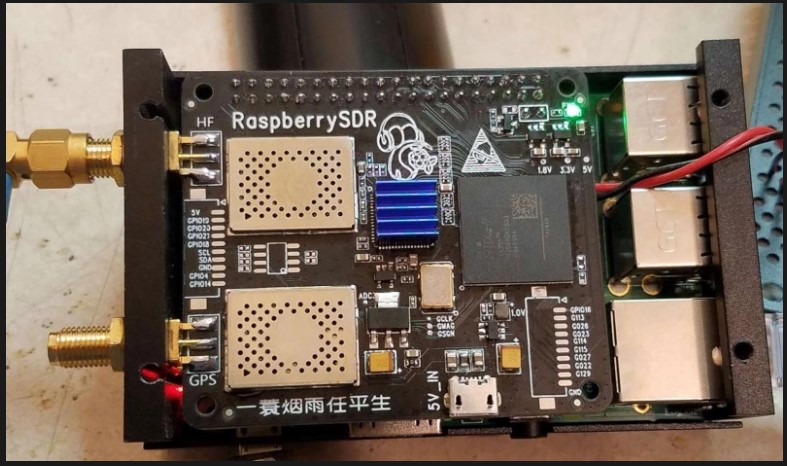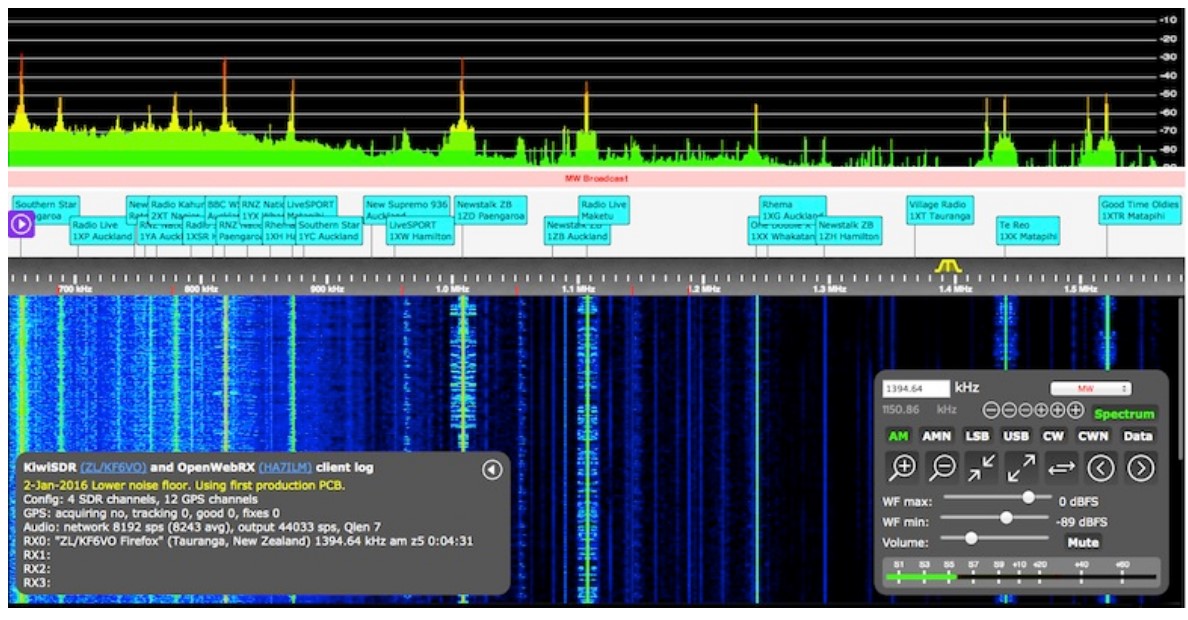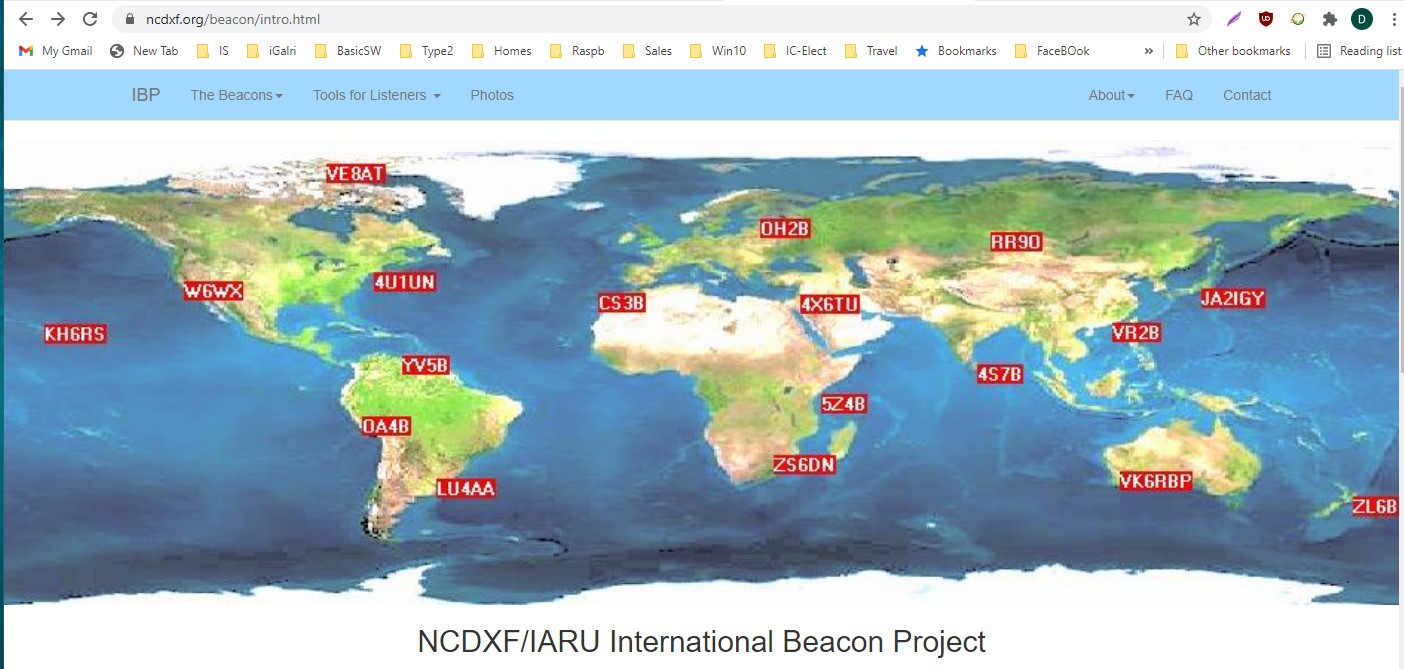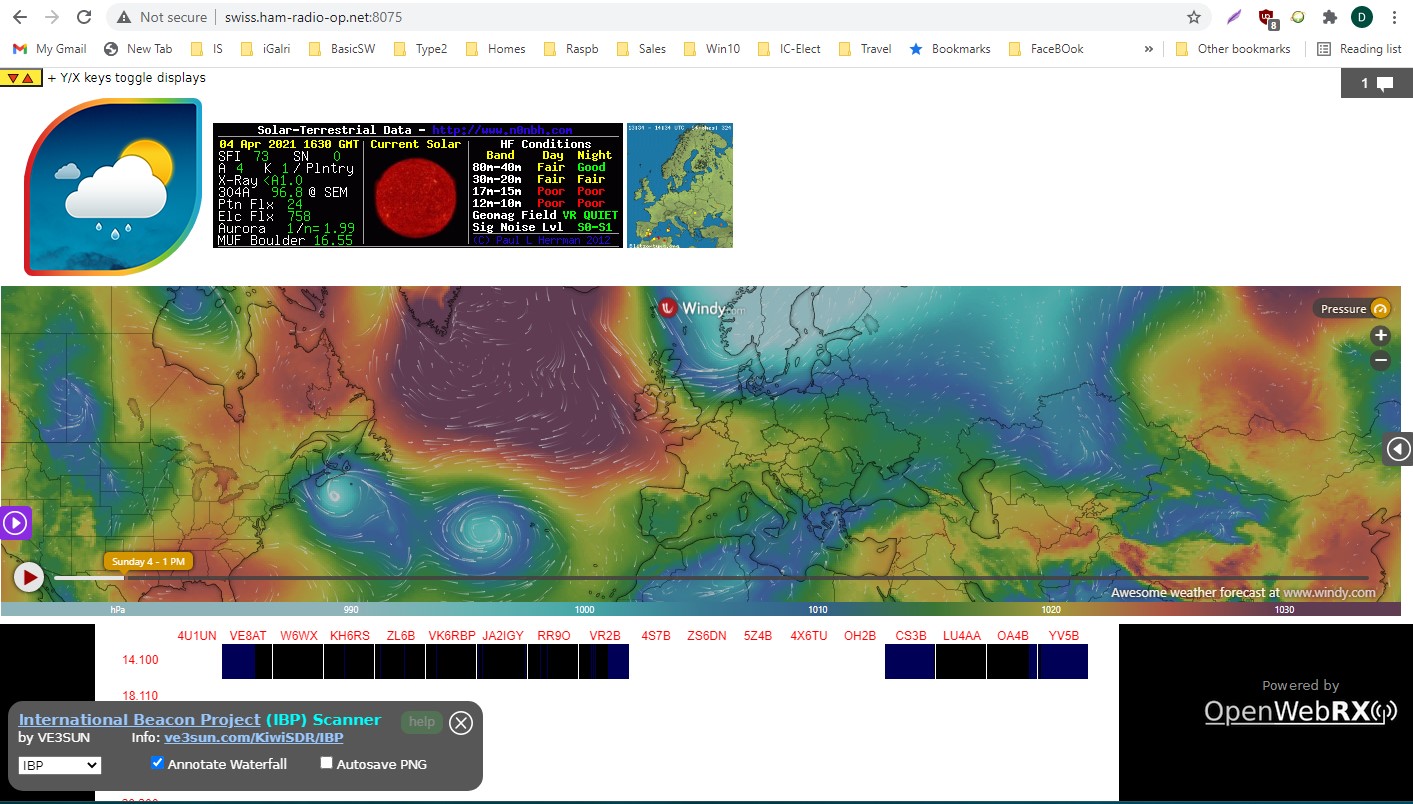HAM: SDR Amateur Radio (162.html)
Keywords: Amateur, Beacon, Canada, "David Cole", Defined, firstCallSign:VE5KS, grid:FN25fi, ham, IBP, KiwiSDR, Morse, ON, Ottawa, Pi, Radio, Raspberry, SDR, Software, VE3IAE
Introduction
After having been away from the HAM scene for 25 years, I have had many surprises. More noise for sure. But the
biggest surprise was the availability of KiWiSDR receivers for me to use . . . anywhere in the world,
thanks to the Internet. The "SDR" is the acronym for Software Defined Radio which is at the
heart of KiWiSDR receivers. The "waterfall" and "spectrum" views of the "air-waves" were perhaps my
biggest surprise. Below, I have provided some photos of the "air-waves" by a KiWiSDR receiver "on loan".
Visually, CW is a perfect vertical line. We can see that AM wastes a lot of its power in the useless carrier
frequency; we can see an LSB and an USB (Upper Side Band) for what it is. But being able to "see" the rigs that are
actually on the air (then "off") is so much better than just turning the dial and listening. I was quite disappointed
with the automatic CW decoder. Then I realized that its poor results were the fault of the LIDs who were on
the keys. Web Source S162:23 below contains a 3 minute audio recording of Morse Code. (It is from a "Beacon"
transmitter. More about these IBP beacons below.) The question comes to mind: Do I need to buy a receiver,
when someone is letting me borrow their receiver and their great antenna? I can even choose from hundreds of antennae
located all over the world. And I haven't even started to explore today's world of repeaters and "chains of
repeaters". The lure of morse code and CW seems to still be there . . . although my coding skills need lots of
work. Enough for tonite . . . its 4:00 am and time to go to bed. A normal bedtime for Ham Radio Operators.
The International Beacon Project (IBP), begun in 1979, is an impressive undertaking. These 18 transmitters, in
various locations worldwide, send signals of known frequency and variable power every 3 minutes on 5 Amateur Bands.
Listening to them gives a Ham Operator a very good "measure" of how signals propogate as of "now". Using KiWiSDR,
anyone can listen to these transmitters . . . from anywhere in the world. See Web Source S162:22 for more info.
(Click on image to Enlarge it)

RaspberrySDR.jpg
(Click on image to Enlarge it)

RaspSDR_Panel.jpg
(Click on image to Enlarge it)

The SDR "Waterfall"
The panel shown above (middle) displays a bandwidth between 700 KHz and 1.6 MHz. This is just below the lowest Amateur Radio Band of 160 meters (1.8 - 2.0 MHz). Apparently, the operator using this Panel is listening to 1394.64 kHz. The frequency "needle" is the yellow "M' shaped thing just below 1.4 MHz on the panel. (The "M" is at 3 o'clock on the panel.) In the above lower image, the bandwidth is from 5 MHz to 60 MHz which covers the 60 meter to 6 meter Amateur Radio bands. This SDR receiver will certainly NOT capture the 2 meter Band. Look at all the red and yellow noise in the 10 meter to 20 meter band zone.
In Web Source S162:11, Carl (K9LA) has provided some information about using the 160 meter Band. The Receiver Panel shown above indicates that it is produced using KiwiSDR (or its clone RaspSDR) hardware and OpenWebRX software. Web Source S162:08, Web Source S162:09 and Web Source S162:10 point to additional information about the OpenWebRX software.
About the necessary computers, in Web Source S162:10, J. Ketterl (ha7ilm) says:
Pretty much any recent machine that runs Linux should do. Many SBCs (Single Board Computers) will work as well, if they do have some decent amount of CPU power. OpenWebRX explicitly supports the Raspberry Pi, we even provide ready-to-go SD card images. The images do not support first-generation "Raspberry Pi"s or the Raspberry Pi Zero, though.
The amount of computing power needed will be determined by various factors: amount of users, bandwidth to be displayed, which modes will typically be used and if background decoding will be enabled. A Raspberry Pi 4 will handle somewhere between 2 and 5 users, whereas an Intel Core i5 will easily handle 20 and more.
*******************************************************************************************
From AliExpress as of 2021DApr01 See Web Source S162:07 RaspSDR *
Huo Guang Store *
RaspberrySDR (2 coax male) *
*
New 16bit 62M real-time bandwidth network shared SDR receiver Raspsdr *
https://www.aliexpress.com/i/4001202057866.html *
US $198.00 *
*
https://www.aliexpress.com/item/4001202057866.html?spm=2114.12057483.0.0.6fdc265cBMCnLw *
*
*******************************************************************************************
KiWiSDR Website by VE3SUN
Peter R. Jennings (VE3SUN) provides a very interesting website at Web Source S162:12. Among many other features, it provides a list of hundreds of owners of KiWiSDR equipment. It also lists the QTH and type of antennas used by each of them. This is a website that should be of interest to many SDR enthusiasts. Something I discovered was the links to their receivers. VE3SUN provides links to many KiWiSDR receivers around the world. Via these internet links, anyone can listen to the KiWi radio at that location. When doing this, one can select the exact frequency that you want the radio to be tuned to. You can change the bandwidth and center the Panel to any frequency. A mouse click on the desired frequency outputs (in audio, of course) what the radio detects, through your computer's speaker, in real time. For example, there is a "clock" transmitter called "CHU CAN" at 7.850 MHz. I was listening to it via the KiWiSDR in Rockport, Maine, courtesy of WA2ZKD/1 . There is usually a limit to the length of time that you can use someone else's KiWiSDR receiver. In this case it was 30 minutes.
Peter Jennings (VE3SUN) has an amazing history of accomplishments, well worth perusing. Another website that VE3SUN references is Web Source S162:13 which lists the KiWiSDR users that are currently online. For example VE3HOA in Ottawa is currentlly online at time of writing.
Friendly KiWiSDR Radio Hosts
ve3hoa Phil Ottawa, Canada ve3hoa.ddns.net:8073 2021DApr02 2 hours
-----------------------------------------------------------------------------------------------------------------
The following notes have not yet been converted into readable text for this article:
[KA7OEI] has a recent blog post (Web Source S162:02) at ka7oei.blogspot.com . He says that the KiwiSDR and the RaspberrySDR are
quite similar, but future models of the RaspberrySDR have more potential, mostly due to wider frequency range and having
2 more bits of resolution.
SDR Radio for Amateurs (Hams)
by Clint Turner ( KA7OEI )
Scribe: D@CC
Date: 2021CMar29
Web Source S162:01: https://hackaday.com/2020/09/30/kiwisdr-vs-raspberrysdr-a-tale-of-two-sdrs/
Web Source S162:02: https://ka7oei.blogspot.com/2020/09/comparing-kiwisdr-and-raspberrysdr.html
[KA7OEI] tells us in a recent blog post at ka7oei.blogspot.com
Web Source S162:03: https://groups.io/g/raspsdr
which is a raspSDR discussion group.
Web Source S162:04:
Web Source S162:for the RaspberrySDR:
Perhaps a bit of "Google-fu" is required, but one possible search phrase for EvilBay [, AliExpress] and AliBaba is this:
"New 16bit 62M real-time bandwidth network shared SDR receiver" [or "RaspSDR"].
Note:
fei666888
October 5, 2020 at 6:36 PM
ADC Ref voltage on RaspSDR of LTC2208 is
1.5V now and can be changed to 2.25V by removing a resistor
Web Source S162:code for RaspberrySDR is here:
https://github.com/raspsdr/Beagle_SDR_GPS
Web Source S162:: 05: https://gigazine.net/gsc_news/en/20210223-amateur-band-intruder/
Gigazine
Web Source S162:: 06 https://www.rtl-sdr.com/tag/raspberrysdr/
RTL-Sdr.com article 2020ISep 20
/SDR_Radio.txt
IBP: International Beacon Project
I tried to hear an IBP using a KiWiSDR from Montreal, QC and was totally unsuccessful. But when I tried using the KiWiSDR provided by VE6SLP in Lamont, Alberta, I had no difficulty at all hearing the 14100 kHz beacon from W6WX in California at 13:08 EST on 2021DApr03. I could hear the W6WX signal at all 4 power levels!!! I could also hear a couple of the other IBP beacons faintly on this channel. The beacons on ALL the other bands could be heard only very faintly, if at all.
KiWiSDR in Lamont, Alberta
Try clicking on the above link and go to frequency 14100 KHz. Better still, using KiWiSDR, click on "CWN", then "Extension", then on "IBP_scan" and then on "All Bands". It will do all the work for you!!!
On 2021DApr03, at 14100 kHz, from KiWiSDR in Alberta, I was able to hear some (at least one) of the dashes of the following IBP sites: VE8AT, W8WX, KH6RS, ZL6B, VR2B. . . . . 45SB, CS3B, YV5B, . Note that W8WX is the strongest beacon heard in Alberta . . . today (being the nearest also). Web Source S162:23 is a recording of the audio CW from these beacons.
(Click on image to Enlarge it)

IBP.jpg
(Click on image to Enlarge it)

IBP_Panel.jpg
The image directly above is my KiWiSDR Panel while searching the beacons recently.
(Click on image to Enlarge it)

IBP-Swiss_0-62.jpg
The Panel above (Web Source S162:24 in Switzerland) is the first KiwiSDR that I have found that "might" scan 0 to 62 MHz. The "waterfall" and audio turned on after I typed in my name/callsign. It often says "audio underrun", until I clicked on the S-meter and then on the message. Doh?? Even then, its operation was inconsistant and intermittent. When functioning correctly, it can "hear" W6WX from California. It uses the same software (OpenWebRX) as other KiwiSDR receivers. I was able to detect some IBP beacons using it. Some Solar-Terrestrial Data appears in the top left corner (Web Source S162:25). See Web Source S162:26 for a description of how it can be used. But it will take lots of studying before I can interpret this Solar data.
Lists of Shared SDR receivers (eg KiwiSDR)
See Web Source S162:12 (by VE3SUN), Web Source S162:13 (Worldwide) and Web Source S162:27 (compiled in Germany, I think). Web Source S162:27 lists those with "Public two-way-radio", but as of 2021 Apr, I don't know what that means. It is of interest to see that "hobiecat.zapto" in Milton, Ontario (W of Mississauga) offers "Public two-way-radio". "hobiecat.zapto" is at Web Source S162:28.
Amateur Radio Bands (Canada)
Band Freq (Web Source S162:29)
(meters) Range (MHz)
160 1.8 - 2.0
80 3.5 - 3.8
60 5.3 - 5.4
40 7.0 - 7.2
30 10.1 - 10.15
20 14.0 - 14.35
10 28.0 - 29.7
6 50 - 54
2 144 - 148
1.25 219 - 225 (excl. 221)
0.13 2300 -2450
The HackRF One (Web Source S162:30) at US$319.95 permits SDR receiving (and transmitting) from Amazon. Web Source S162:31 compares many SDR and recommends the HackRF.
Web Source S162:s
Web Sources
Web Source S162:01: KiwiSDR vs RaspberrySDR  by Al Williams on 2020ISep 30
by Al Williams on 2020ISep 30
Web Source S162:02: Comparing KiwiSDR vs RaspberrySDR  by ka7oei
by ka7oei
Web Source S162:03: a raspSDR discussion group.  raspsdr @ groups.io
raspsdr @ groups.io
Web Source S162:04: Web Source S162:Code for RaspberrySDR  at Github
at Github
Web Source S162:04A: The new FlyDog link  at Github as of 2020ISep 20
at Github as of 2020ISep 20
Web Source S162:05: Intruder above 20m  in Gigazine by KA7OEI on 2021BFeb 23
in Gigazine by KA7OEI on 2021BFeb 23
Web Source S162:06: RTL-Sdr.com article 2020ISep 20 
Web Source S162:07: US$198.00 RaspSDR at AliExpress  from huo guang Store
from huo guang Store
Web Source S162:08: OpenWebRX Client Log 
Web Source S162:09: OpenWebRX Raspberry Images  Latest Release
Latest Release
Web Source S162:10: OpenWebRX Documentation  by walzert on 2020HAug29
by walzert on 2020HAug29
Web Source S162:11: Introduction to the 160m Band  by Carl Luetzelschwab in 2006
by Carl Luetzelschwab in 2006
Web Source S162:12: Usable KiWiSDR Receivers worldwide  by VE3SUN in 2021
by VE3SUN in 2021
Web Source S162:13: KIWISDR receivers List  in 2021
in 2021
Web Source S162:14: KIWISDR Forum  in 2021DApr02
in 2021DApr02
Web Source S162:15: Omniglot Morse Code  in 2021DApr02
in 2021DApr02
Web Source S162:16: Ham Radio QRP Abbr.  in 2021DApr02
in 2021DApr02
Web Source S162:17: Long Table of Morse Abbr.  pp25 in 2021DApr02
pp25 in 2021DApr02
Web Source S162:18: Intro to KiwiSDR  pp25 in 2021DApr02
pp25 in 2021DApr02
Web Source S162:19: Detailed KiwiSDR Install. Instructions  ~pp50 as of 2021CMar30
~pp50 as of 2021CMar30
Web Source S162:20: 2 letter Abbr. for Prov & States  as of 2021DApr02
as of 2021DApr02
Web Source S162:21: Public Rx KiWi  as of 2021DApr02
as of 2021DApr02
Web Source S162:22: IBP:International Beacon Project: Schedule  by VE3SUN 2021DApr03
by VE3SUN 2021DApr03
Web Source S162:23: IBP:Audible Beacon Recording (3 minutes)  from VE6SLP 2021DApr03
from VE6SLP 2021DApr03
Web Source S162:24: 0.1-62 RaspSDR? in Switzerland:  from HE9JAP at JN36hm as of 2021DApr04
from HE9JAP at JN36hm as of 2021DApr04
Web Source S162:25: Solar Terrestrial Data  by N0NBH as of 2021DApr04
by N0NBH as of 2021DApr04
Web Source S162:26: Understanding/Using Solar Terrestrial Data  by N0NBH as of 2021DApr04
by N0NBH as of 2021DApr04
Web Source S162:27: Receiverbook (Includes Public two-way radio)  .de as of 2021DApr18
.de as of 2021DApr18
Web Source S162:28: hobiecat.zapto (Includes Public two-way radio)  as of 2021DApr18
as of 2021DApr18
Web Source S162:29: Amateur Radio Frequencies  Wikipedia as of 2021EMay17
Wikipedia as of 2021EMay17
Web Source S162:30: HackRF SDR incl Ant. 1-6,000 MHz by NooElec at Amazon US$319.95
by NooElec at Amazon US$319.95
Web Source S162:31: The best SDR devices  from Thee Best Ham Radio as of 2021EMay17
from Thee Best Ham Radio as of 2021EMay17
Web Source S162:32: GNU radio (eg SDR 4.0)  DSSoC, DARPA, BlackLynx, OpenSDR by Josh Morman 2021EMay17
DSSoC, DARPA, BlackLynx, OpenSDR by Josh Morman 2021EMay17
WebMaster: Ye Old King Cole
Date Created: 2021 D Apr 01
Date Updated: 2021 E May 17
/162.html






 by Al Williams on 2020ISep 30
by Al Williams on 2020ISep 30 by ka7oei
by ka7oei  raspsdr @ groups.io
raspsdr @ groups.io at Github
at Github at Github as of 2020ISep 20
at Github as of 2020ISep 20 in Gigazine by KA7OEI on 2021BFeb 23
in Gigazine by KA7OEI on 2021BFeb 23 
 from huo guang Store
from huo guang Store 
 Latest Release
Latest Release  by walzert on 2020HAug29
by walzert on 2020HAug29  by Carl Luetzelschwab in 2006
by Carl Luetzelschwab in 2006  by VE3SUN in 2021
by VE3SUN in 2021  in 2021
in 2021  in 2021DApr02
in 2021DApr02  in 2021DApr02
in 2021DApr02  in 2021DApr02
in 2021DApr02  pp25 in 2021DApr02
pp25 in 2021DApr02  pp25 in 2021DApr02
pp25 in 2021DApr02  ~pp50 as of 2021CMar30
~pp50 as of 2021CMar30  as of 2021DApr02
as of 2021DApr02  as of 2021DApr02
as of 2021DApr02  by VE3SUN 2021DApr03
by VE3SUN 2021DApr03  from VE6SLP 2021DApr03
from VE6SLP 2021DApr03  from HE9JAP at JN36hm as of 2021DApr04
from HE9JAP at JN36hm as of 2021DApr04  by N0NBH as of 2021DApr04
by N0NBH as of 2021DApr04  by N0NBH as of 2021DApr04
by N0NBH as of 2021DApr04  .de as of 2021DApr18
.de as of 2021DApr18  as of 2021DApr18
as of 2021DApr18  Wikipedia as of 2021EMay17
Wikipedia as of 2021EMay17  by NooElec at Amazon US$319.95
by NooElec at Amazon US$319.95  from Thee Best Ham Radio as of 2021EMay17
from Thee Best Ham Radio as of 2021EMay17  DSSoC, DARPA, BlackLynx, OpenSDR by Josh Morman 2021EMay17
DSSoC, DARPA, BlackLynx, OpenSDR by Josh Morman 2021EMay17